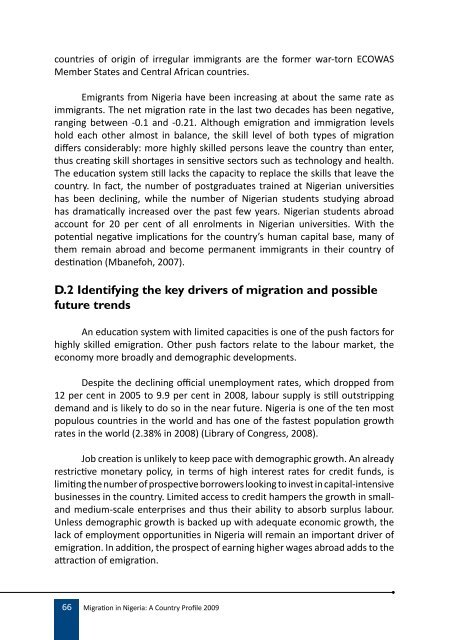Migration Profile on Nigeria - IOM Publications - International ...
Migration Profile on Nigeria - IOM Publications - International ...
Migration Profile on Nigeria - IOM Publications - International ...
Create successful ePaper yourself
Turn your PDF publications into a flip-book with our unique Google optimized e-Paper software.
countries of origin of irregular immigrants are the former war-torn ECOWAS<br />
Member States and Central African countries.<br />
Emigrants from <strong>Nigeria</strong> have been increasing at about the same rate as<br />
immigrants. The net migrati<strong>on</strong> rate in the last two decades has been negative,<br />
ranging between -0.1 and -0.21. Although emigrati<strong>on</strong> and immigrati<strong>on</strong> levels<br />
hold each other almost in balance, the skill level of both types of migrati<strong>on</strong><br />
differs c<strong>on</strong>siderably: more highly skilled pers<strong>on</strong>s leave the country than enter,<br />
thus creating skill shortages in sensitive sectors such as technology and health.<br />
The educati<strong>on</strong> system still lacks the capacity to replace the skills that leave the<br />
country. In fact, the number of postgraduates trained at <strong>Nigeria</strong>n universities<br />
has been declining, while the number of <strong>Nigeria</strong>n students studying abroad<br />
has dramatically increased over the past few years. <strong>Nigeria</strong>n students abroad<br />
account for 20 per cent of all enrolments in <strong>Nigeria</strong>n universities. With the<br />
potential negative implicati<strong>on</strong>s for the country’s human capital base, many of<br />
them remain abroad and become permanent immigrants in their country of<br />
destinati<strong>on</strong> (Mbanefoh, 2007).<br />
D.2 identifying the key drivers of migrati<strong>on</strong> and possible<br />
future trends<br />
An educati<strong>on</strong> system with limited capacities is <strong>on</strong>e of the push factors for<br />
highly skilled emigrati<strong>on</strong>. Other push factors relate to the labour market, the<br />
ec<strong>on</strong>omy more broadly and demographic developments.<br />
Despite the declining official unemployment rates, which dropped from<br />
12 per cent in 2005 to 9.9 per cent in 2008, labour supply is still outstripping<br />
demand and is likely to do so in the near future. <strong>Nigeria</strong> is <strong>on</strong>e of the ten most<br />
populous countries in the world and has <strong>on</strong>e of the fastest populati<strong>on</strong> growth<br />
rates in the world (2.38% in 2008) (Library of C<strong>on</strong>gress, 2008).<br />
Job creati<strong>on</strong> is unlikely to keep pace with demographic growth. An already<br />
restrictive m<strong>on</strong>etary policy, in terms of high interest rates for credit funds, is<br />
limiting the number of prospective borrowers looking to invest in capital-intensive<br />
businesses in the country. Limited access to credit hampers the growth in small-<br />
and medium-scale enterprises and thus their ability to absorb surplus labour.<br />
Unless demographic growth is backed up with adequate ec<strong>on</strong>omic growth, the<br />
lack of employment opportunities in <strong>Nigeria</strong> will remain an important driver of<br />
emigrati<strong>on</strong>. In additi<strong>on</strong>, the prospect of earning higher wages abroad adds to the<br />
attracti<strong>on</strong> of emigrati<strong>on</strong>.<br />
66 <str<strong>on</strong>g>Migrati<strong>on</strong></str<strong>on</strong>g> in <strong>Nigeria</strong>: A Country <str<strong>on</strong>g>Profile</str<strong>on</strong>g> 2009

















